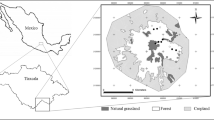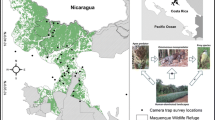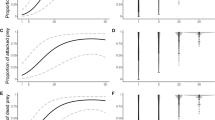Abstract
Recently two species of carabid beetle were accidentally introduced onto the sub-Antarctic island of South Georgia. Both species are carnivorous and flightless. One of the species, Trechisibus antarcticus, is locally very abundant and in the process of invading the coastal lowland area, where the endemic herbivorous beetle Hydromedion sparsutum (Perimylopidae) is common. Field samples showed the abundance of the endemic species to be much lower, and its adult body size to be larger, in carabid-infested locations than in carabid-free locations. The sample data allowed us to estimate the growth rate of the H. sparsutum larvae and to reconstruct the most likely life-cycle of both species. A laboratory experiment showed a high mortality for the first three (out of six) larval instars of H. sparsutum in groups which had been subjected to predation by T. antarcticus. The duration of the period during which the larvae are vulnerable to predation was shown in a growth experiment to depend on food type. Quantitative and qualitative aspects of the interaction between the introduced predator and the endemic prey, and conditions which allowed the former to invade are discussed.
Similar content being viewed by others
References
Block W (1988) South Georgian entomology. Antenna 12:97–102
Block W, Sømme L (1983) Low temperature adaptations in beetles from the sub-Antarctic island of South Georgia. Polar Biol 2:109–114
Chown SL, Smith VR (1993) Climate change and the short term impact of feral house mice at the sub-antarctic Prince Edward Islands. Oecologia 96:508–516
Darlington PJ (1970) Coleoptera: Carabidae of South Georgia. Pac Insects Monogr 23:234
Davies L (1987) Long adult life, low reproduction and competition in two sub-Antarctic carabid beetles. Ecol Entomol 12:149–162
Elton CS (1958) The ecology of invasions by animals and plants. Methuen, London
Ernsting G (1993) Observations on life cycle and feeding ecology of two recently introduced predatory beetles at South Georgia, Sub-Antarctic. Polar Biol 13:423–428
Ernsting G, Isaaks JA, Berg MP (1992) Life cycle and food availability indices in Notiophilus biguttatus (Coleoptera, Carabidae). Ecol Entomol 17:33–42
Ernsting G, Zonneveld C, Isaaks JA, Kroon A (1993) Size at maturity and patterns of growth and reproduction in an insect with indeterminate growth. Oikos 66:17–26
Gadgil M, Bossert WH (1970) Life historical consequences of natural selection. Am Nat 104:1–24
Gray AJ, Crawley MJ, Edwards PJ (eds) (1987) Colonization, succession and stability. Proceedings of the 26th Symposium of the British Ecological Society. Blackwell, Oxford
Gressitt JL (ed) (1970) Subantarctic entomology, particularly of South Georgia and Heard Island. Pac Insects Monogr 23
Haderspeck W, Hoffmann KH (1990) Effects of photoperiod and temperature on development and reproduction of H. sparsutum (Müller) (Coleoptera, Perimylopidae) from South Georgia (Subantarctic). Oecologia 83:99–104
Headland RK (1984) The island of South Georgia. Cambridge University Press, Cambridge
Hengeveld R (1989) Dynamics of biological invasions. Chapman and Hall, London
Jeannel R (1940) Croisière du Bougainville aux Iles Australes Francaises. Mem Mus Natl Hist Nat XIV:63–201
Law R (1979) Optimal life histories under age specific predation. Am Nat 114:399–417
Lawton JH, Brown KC (1986) The population and community ecology of invading insects. Philos Trans R Soc Lond B 314:607–617
Lynch M (1980) The evolution of cladoceran life histories. Q Rev Biol 55:23–42
MacArthur RH, Wilson EO (1967) The theory of island biogeography. Princeton University Press, Princeton
Meyer-Arndt S (1984) Growth and development of Hydromedion sparsutum (Müller) (Coleoptera, Perimylopidae) from South Georgia at different temperatures. Polar Biol 3:39–44
Mooney HA, Hamburg SP, Drake JA (1986) The invasions of plants and animals into California. In: Mooney HA, Drake JA (eds) Ecology of biological invasions of North America and Hawaii. Springer, New York Berlin Heidelberg, pp 250–272
Moulton MP, Pimm SL (1986) Species introductions to Hawaii. In: Mooney HA, Drake JA (eds) Ecology of biological invasions of North America and Hawaii. Springer, New York Berlin Heidelberg, pp 231–249
Niemelä J, Spence JR (1991) Distribution and abundance of an exotic ground-beetle (Carabidae): a test of community impact. Oikos 62:351–359
Ottesen PS (1990) Diel activity patterns of Carabidae, Staphylinidae and Perimylopidae (Coleoptera) at South Georgia, Sub-Antarctic. Polar Biol 10:515–519
Pimm SL (1991) The balance of nature? University of Chicago Press, Chicago
Reznick DA (1983) The impact of predation on life history evolution in Trinidadian guppies (Poecilia reticulata). Evolution 36:160–177
Reznick DA, Bryga H, Endler JA (1990) Experimentally induced life history evolution in a natural population. Nature 346:357–359
Ring RA, Block W, Sømme L, Worland MR (1990) Body water content and desiccation resistance in some arthropods from South Georgia, sub-Antarctic. Polar Biol 10:581–588
Roff DA (1992) The evolution of life histories. Theory and analysis. Chapman and Hall, New York
Roux PR, Voisin J-F (1982) Notes sur les Carabiques des Iles Falkland (Col., Carabidae). Bull Soc Entomol 87:200–204
Simberloff D (1986) Introduced insects: a biogeographic and systematic perspective. In: Mooney HA, Drake JA (eds) Ecology of biological invasions of North America and Hawaii. Springer, New York Berlin Heidelberg, pp 3–26
Smith RIL, Walton DWH (1975) South Georgia, Subantarctic. In: Rosswall T, Heal OW (eds) Structure and function of tundra ecosystems. Ecol Bull (Stockh) 20:399–423
Sokal RR, Rohlf FJ (1981) Biometry. Freeman, New York
Sømme L, Ring RA, Block W, Worland MR (1989) Feeding in the two phytophagous beetles Hydromedion sparsutum and Perimylops antarcticus from South Georgia. Polar Biol 10:141–143
Vogel M (1985) The distribution and ecology of epigeic invertebrates on the subantarctic island of South Georgia. Spixiana 8:153–163
Vogel M, Remmert H, Smith RIL (1984) Introduced reindeer and their effects on the vegetation and the epigeic invertebrate fauna of South Georgia (subantarctic). Oecologia62:102–109
Watt JC (1970) Coleoptera: Perimylopidae of South Georgia. Pac Insects Monogr 23:243–253
Author information
Authors and Affiliations
Corresponding author
Rights and permissions
About this article
Cite this article
Ernsting, G., Block, W., MacAlister, H. et al. The invasion of the carnivorous carabid beetle Trechisibus antarcticus on South Georgia (sub-Antarctic) and its effect on the endemic herbivorous beetle Hydromedion spasutum . Oecologia 103, 34–42 (1995). https://doi.org/10.1007/BF00328422
Received:
Accepted:
Issue Date:
DOI: https://doi.org/10.1007/BF00328422




